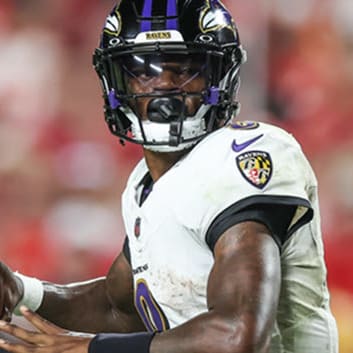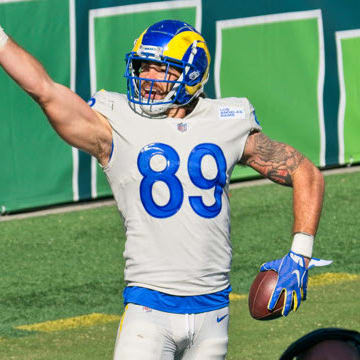This article is part of our Dynasty Strategy series.
Bigger value swings will come in April after free agency and the draft, but even in early February we already have some new information impacting player valuations. Coaching changes are an easy place to start, though any attempt at reaching conclusions tends to be highly subjective when the coach in question doesn't have much NFL experience or has never been more than a coordinator — and sometimes just a special teams coordinator — at the pro level.
Other relevant information since the end of the regular season includes playoff games (Damien Williams ⬆️), injury news (Rashaad Penny ⬇️), draft rumors (Tyler Boyd ⬆️), free agency rumors (Robby Anderson ⬇️) and even the occasional transaction (Ian Thomas ⬆️). The rumors, of course, are something we need to be careful with. Sometimes there's fire where there's smoke, but other times it turns out to be nothing more than a vape cloud.
(Please don't actually watch this video)
Gaining Value ⬆️
QB Baker Mayfield,  Cleveland Browns
Cleveland Browns
This is less about Kevin Stefanski and more about Freddie Kitchens being out of the picture. Kitchens was the rare interim head coach to actually keep the job the following season, and his results suggest he'll be the last to do so for a while. This is one of the few cases where I'm fine with assuming addition by subtraction, even though I foolishly bought into the Kitchens hype after last offseason. Look at this goon:
(Don't watch this one either)
RB Damien Williams,  Kansas City Chiefs
Kansas City Chiefs
The Chiefs currently are scheduled for $13.7 million in cap space, and their starting halfback closed out the season with 536 total yards and nine touchdown in his last five games, nearly winning a Super Bowl MVP award in the process. Does that sound like a team that's likely to devote a large contract or a first-round pick to a running back?
I guess the latter can't be ruled out, but anything earlier than late second round would be new territory for both GM Brett Veach and coach Andy Reid (including their respective tenures in Philadelphia). Even if they free up cap space by cutting Sammy Watkins ($14 million) and one or two other veterans, the Chiefs likely will use their first few draft picks on higher-priority positions than RB, considering they have four starters — including Super Bowl hero Chris Jones — scheduled to become unrestricted free agents.
WR Tyler Boyd,  Cincinnati Bengals
Cincinnati Bengals
Boyd dealt with five games of Jeff Driskel in 2018 and three weeks of Ryan Finley in 2019, nonetheless managing a pair of 1,000-yard seasons. The wide receiver now figures to enter his age-26 campaign connected to a No. 1 overall pick, with Joe Burrow starting his rookie contract right as Boyd enters the first season of a four-year, $43 million extension. There's always some short-term risk in being tied to a rookie QB, but Boyd's long-term ceiling gets a big lift with Burrow presumably replacing 32-year-old Andy Dalton as the franchise cornerstone.
TE Ian Thomas,  Carolina Panthers
Carolina Panthers
I've never been impressed when I've watched Thomas play football, and my skepticism gets some support from his poor grades from Pro Football Focus as well as his career mark of 5.9 yards per target (with 52 catches and six drops). Even so, there's no doubt Greg Olsen's departure from Carolina creates an opportunity, especially when the other tight ends on the roster are Temarrick Hemingway and someone named Marcus Baugh.
The Panthers would be wise to add a solid veteran and/or an early draft pick at tight end, but that doesn't necessarily mean it's what they'll do, as any investment entails the opportunity cost of using resources that otherwise could be deployed toward fixing a league-worst run defense or finding Cam Newton's replacement (gasp) at quarterback. It wouldn't be crazy to roll the dice on a three-down role for Thomas, a 91st-percentile SPARQ athlete who turns 24 in June.
Overshadowed by Mike Gesicki's Vernon Davis-esque day, let's not forget:
Ian Thomas (4.74 40--36" vert--10'3" broad--7.15 3 cone--4.2 ss @ 6'3 5/8" 259 lb)
Tyler Conklin (4.8 40--38" vert--10' broad--7.13 3 cone--4.23 ss @ 6'3" 254)
Both fit in among top WR w exception of 40
— Sigmund Bloom (@SigmundBloom) March 4, 2018
TE Jaeden Graham,  Atlanta Falcons
Atlanta Falcons
The Falcons are stuck in salary-cap hell, and we've already seen neutral-to-pessimistic comments from each of Austin Hooper, GM Thomas Dimitroff and owner Arthur Blank regarding the team's chances of retaining its 25-year-old breakout star. The cap limitations suggest Hooper's "replacement" likely would come from the draft or the bottom of the free-agent pool, with someone like Tyler Eifert representing the team's best-case scenario for a veteran addition.
The Falcons ultimately may allow Graham to compete for the top pass-catching role at TE, playing in an offense that threw 684 passes in 2019 and 617 the year prior. Graham is an undrafted FCS product with just one year of receiving production at Yale and mediocre workout metrics, but he did make some noise when Hooper suffered a knee injury in November, catching seven of eight targets for 117 yards and a touchdown over a three-week stretch while handling snap shares of 52, 66 and 58 percent.
Graham probably won't ever be a player who is prioritized in his team's passing game, but he could be a Cameron Brate or Jacob Hollister type, i.e., capable of low-end TE1 production in an offense that regularly visits the red zone and often looks to its tight ends near the goal line. That potential is enough to warrant a bench spot in deep dynasty leagues.
Neither Thomas Dimitroff at the Senior Bowl or Arthur Blank today in Miami sound very warm and fuzzy about Austin Hooper. 👀 https://t.co/rOQpCxZn0b
— Kelly Price (@thekellyprice) January 29, 2020
Losing Value ⬇️
QB Ryan Fitzpatrick,  Miami Dolphins
Miami Dolphins
The Dolphins want Fitzpatrick to stick around for the second season of a two-year contract, but they didn't feel the same way about former offensive coordinator Chad O'Shea, who was replaced by Chan Gailey shortly after Week 17. The 68-year-old Gailey is familiar to most NFL fans, but he's been out of coaching since 2016 and has a mediocre track record as both a HC and OC.
The continuity with O'Shea would've been nice, likely giving Fitzpatrick an added advantage over whichever rookie quarterback the Dolphins end up drafting. The rumor mill increasingly hints at Tua Tagovailoa (hip), who might not be a threat for the Week 1 job but would be tough to keep off the field for an entire season. Tagovailoa's agent, Leigh Steinberg, expects that the young QB will make enough progress in his recovery to work out for NFL teams this spring, per The Palm Beach Post.
RB Rashaad Penny,  Seattle Seahawks
Seattle Seahawks
Coach Pete Carroll revealed that Penny suffered additional knee damage beyond an ACL tear in December, while fellow Seahawks running back Chris Carson is expected to avoid surgery on a hip injury. Toss in a solid late-season cameo from rookie Travis Homer and it's fair to wonder if Penny will have a significant role once he's cleared to play. That may not even happen until October or later, given the unfortunate timing of his injury. I guess there's an argument to buy low here, but only if you're fine with using a roster spot on a possible goose egg for the upcoming season.
WR Robby Anderson,  New York Jets ?
New York Jets ?
Anderson seemed fed up with the Jets when he spoke to the media after Week 17, presumably ready to depart for greener pastures without a second thought. Alas, his recent comments paint a different picture, one where the speedy wide receiver mentions mutual interest between himself and the only team he's ever known. Maybe he's just trying to create some extra leverage for negotiations with a new club, but that shouldn't really be necessary for a player who is sure to field multiple offers from other teams if he doesn't re-sign before the free agency period.
Anderson's dynasty owners should hope he finds his way to a franchise with a decent offensive line and a better head coach. It's not just that Adam Gase does a poor job of consistently getting the ball to his best players; he also favors a slow-paced offense that tends to limit overall volume. One might think that all the losing would lead to a lot of throwing, but the 2019 Jets ranked 22nd in pass attempts (521) and the 2018 Dolphins were 30th (455).
Adam Gase's offenses finished dead last in pace of play (plays per gm) in 2 of 3 seasons in Miami.
He privately threw Ryan Tannehill under the bus to explain it away.
Jets are 31st in plays per game this year. Meanwhile, Tannehill is on fire
Story: https://t.co/hFhiEV0bsN pic.twitter.com/PKqBJknm8b
— Manish Mehta (@MMehtaNYDN) December 3, 2019
TE Jacob Hollister,  Seattle Seahawks
Seattle Seahawks
It might seem like I'm overthinking, or perhaps overreacting to Greg Olsen's scheduled visit to Seattle. After all, Olsen already visited with the Bills, and that doesn't have me worried about Dawson Knox's dynasty value. So, what's the difference between the two situations?
For me, it's pretty simple: Whatever value Hollister might have — probably not much — depends on the hope for 2020 production. He's already 26 years old, he isn't a good blocker, and he produced 5.9 yards per target in 2019 in the same offense where Will Dissly put up 9.7 YPT before suffering an Achilles tear.
Hollister's value isn't about his talent, because he doesn't have much of it. Rather, his value lies in being a warm body with regular playing time on the same football field as Russell Wilson. The question, then, is whether said situation persists for another year (or at least the first month or two of the season)?
Seattle's interest in Olsen is our first hint that the answer is ' no', despite Dissly facing an uncertain future after his second severe injury in two pro seasons. Even if Olsen doesn't sign, the Seahawks are set up with $50.8 million in cap space and an extra second-round pick, i.e., plenty of resources to upgrade at TE even after they re-sign some of their own free agents.
On the other hand, Knox, a.k.a. Sr. Dropsalot, is 23 years old and a recent third-round pick, coming off a rookie season where he somehow muffed 10 of his 50 targets but also earned PFF's sixth-best run blocking grade among qualified tight ends. The signing of a veteran pass catcher at TE obviously wouldn't be ideal for Knox's 2020 value, but it wouldn't necessarily prevent him from handling an every-down role in 2021 and beyond.
We should also mention that in 2019 the Bills had 1,338 cumulative TE snaps (1.25 per team snap), compared to 1,168 (1.05 per team snap) for the Seahawks. Injuries played a big role in Seattle's heavy reliance on three/four-wide formations, but the same also can be said of the Bills, and I think Dissly is far more relevant than Tyler Kroft — a potential cap casualty — in any equation for determining 2020 target distributions.












